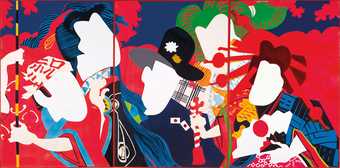Was ‘pop art’ a term used by yourself or colleagues or was there a different terminology that referred to a new figurative art movement in the 1960s and early 1970s?
In the early 1960s, the term pop art was very fashionable; however, after just a few years, op art, conceptual, and environmental art, which had developed a bit later, took over and the term became an out-dated fashionable term.
Did you ever consider yourself (now or in the past) a pop artist?
I have never thought of myself as a pop artist. At the time, I just gave up my drawing and brushstroke skills and started using a stencil method.
Did your work engage with current events in the 1960s and early 1970s?
When creating works, I always intend to ride the flow of the world and fight at the front. Of course I also joined the flow at that time.

Ushio Shinohara
Doll Festival 1966
Hyogo Prefectural Museum of Art (Yamamura Collection)
© Ushio and Noriko Shinohara
How did you choose the subject matter for your work included in The World Goes Pop?
It is an honour [that my works will be shown in the exhibition]. At that time I put all my energy into this group of works. The fact that I will be able to see them in an international group exhibition makes me happy beyond words.
Where did you get your imagery from (what, if any, sources did you use)?
I was inspired by Japanese wood block prints from the Edo period [1603–1868].
Were you aware of pop art in other parts of the world?
I care very much. I would especially like to see sculptures by pop artists. It is not enough that there are works by Oldenburg and George Segal.
Was commercial art an influence on your work or the way in which it was made?
Commercial art does not allow an artist to be too self-centred and self-satisfied. . It is therefore attractive to lonely artists who are working by themselves in their studio.
Was there a feeling at the time that you doing something important and new, making a change…?
During the opening of the Tokyo Olympics in 1964, the whole of Japan was very excited. All of us young artists were feeling a sense of fulfilment while creating works.
Was there an audience for the work at the time – and if so what was their reaction to it?
The Japan of that time did not have any art dealers. We as artists organised group exhibitions to present our works and only related people from the art world were excited about them. There were no collectors, either.
Looking back at these works, what you do think about them now?
I was at the height of my youth. I was full of youth and energy, fresh ideas and a strong feeling of curiosity about America and Europe. The decade was like a rainbow and today there are only a few works left from that time so these are really precious.
September 2015
